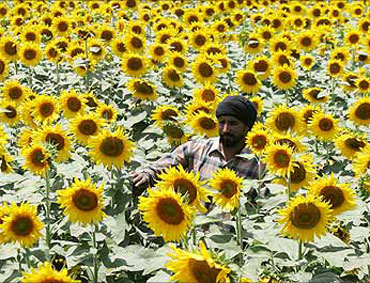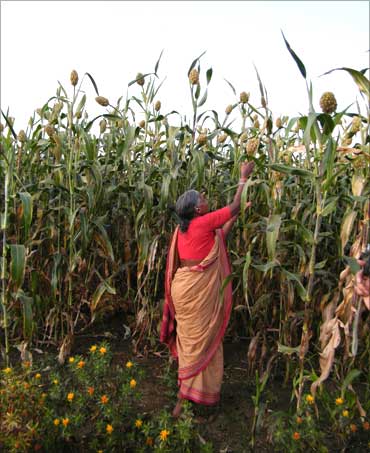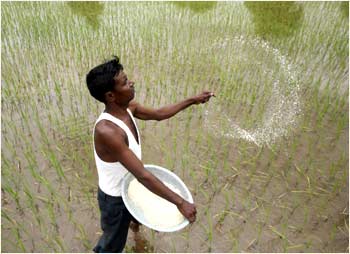 | « Back to article | Print this article |
Yours truly, a farmer
Disputes surrounding the Food Security Bill are the tip of an iceberg.
On the surface it seems like a quarrel about how many poor Indians should be eligible for food assistance and through what means. What lurks beneath the surface is a multi-dimensional crisis of our food systems, soil quality and water management.
Some form of food security legislation is a necessary emergency measure for the poorest of the poor. But it clearly cannot address the heart of the matter. So what can be done to solve those overlapping crises?
There are stacks of government reports and scholarly studies that attempt to answer this question. But some of the most poignant insights have been captured in a diary that was originally published in Telegu under the title 'Yours truly, a farmer'.
G Narendranath, the author, started out as an officer for the State Bank of Hyderabad. Bored with number crunching and spurred by the longing for social transformation, he quit banking.
In 1987, Narendranath and his wife Uma Shankari settled on the family's ancestral farm in Chittoor district of Andhra Pradesh.
Their experiences as farmers and social activists, now recorded in English, offer us many vantage points from which to explore that core question. In a string of cautionary tales this one stands out in particular.
Early in their farming life the couple became deeply interested in the system of tanks which have traditionally ensured water supply for thousands of acres of agricultural land in an area of erratic rainfall.
Click NEXT to read on . . .
Yours truly, a farmer
Built over the centuries there are, even today, 80,000 such tanks in Andhra Pradesh.
In hilly terrain the tanks are linked, with the surplus of higher level tanks flowing into those downhill. These tanks were usually built by kings or local chieftans and maintained by them with participation of the local community. It return the king or feudal lord collected a sixth of the produce from such lands.
It was under British rule that the government began to claim half the produce -- thus impoverishing the local people and displacing the social values which ensured maintenance of the tanks.
When this resulted in lower revenues for the government, the British realized their mistake and set up committees to find solutions. But, writes Narendranath, they were unwilling to part with their overall claim to the ownership of the tanks and their 'right' to claim a large share of the produce.
Simultaneous decline of collective infrastructure and values eventually made way for the onset of electric irrigation pumpsets backed by subsidised electric and diesel power.
Aggressive tubewell irrigation led to severe depletion of water resources. In Narendranath's village, Venkatrampuram, the water table was at about 40 to 50 feet just 20 years ago.
After years of growing water-intensive cash crops like sugarcane and paddy, the water table has fallen to 500 feet. Today, in most villages of Chittoor district even drinking water is scarce.
But the actual borewells were not as damaging as the shift in people's attitudes. The real damage, Narendranath realised, was done by the 'each-one-for-himself and the-devil-take-care-of-the-rest attitude'.
Click NEXT to read on . . .
Yours truly, a farmer
This fundamental insight is a key to unlocking several puzzles. It helps us to focus on the core challenge of our times: how to find new ways of matching our collective interest with individual interest.
By extension this includes the interests of generations yet to come.
Population pressure alone does not explain the scale at which soil quality, water availability and bio-diversity are all being depleted. These losses are being driven by an extremely narrow definition of self-interest and efficiency.
In agriculture both market and public policy have limited 'efficiency' to an equation between area, production and yield. Any farmer earning more money from the same area of land has been deemed successful, with virtually complete disregard for the larger context -- or even the long-term sustainability of his own farm.
Contrast this with the more all-encompassing definition of both self-interest and efficiency in a village where tree cover, fields and grazing lands are collectively nurtured and kept in balance.
This becomes increasingly difficult, wrote Narendranath, once 'the basic motivating factor for the farmer, like any one else, is relatively easy money'.
Narendranath lived his own life in complete defiance of this pervasive social and economic trend. Clad in a white cotton dhoti-kurta he worked gently for a shift in values as much as farming methods.
When he passed away in July 2009, at the age of 57, thousands gathered at his funeral at Venkatrampuram.
Click NEXT to read on . . .
Yours truly, a farmer
'Dilemmas in Agriculture: A Personal Story' was translated into English by Narendranath during an year-long illness and later completed by Uma. The concise, beautifully-produced booklet makes a passionate case for eco-friendly farming and yet cautions that such farming cannot immediately ensure self-sufficiency in food production for the entire nation.
But improvements in methods, technologies and institutional supports could show substantial results over the years.
It alerts us to the counter-productive effects of well intended actions. For example, in the 1980s N T Rama Rao became a hero by issuing rice for Rs 2 a kg under the Public Distribution System in Andhra Pradesh.
But, this caused a fall in the consumption of locally produced millets -- which were nutritionally much richer than polished rice -- which was inevitably coated with pesticides during storage.
So while distribution of cheap rice was a necessary palliative -- prolonged use of such policies, accompanied by neglect of the crisis of agriculture, proved detrimental both for nutritional levels and farming.
Click NEXT to read on . . .
Yours truly, a farmer
This is one factor in the complex mess that has resulted in over 2.5 lakh (250,000) farmers across India committing suicide over the last 15 years.
Reviving cultivation of ragi, bajra and other millets would help revive the soils as well as improve nutritional levels.
But people no longer consume millets because it is cheaper to eat the subsidised polished rice sold at ration shops.
Besides, as Narendranath observed: 'Eating rice is considered socially superior to eating ragi or jowar. We have been eating unpolished rice for the last 12 years but have not been able to persuade our neighbours and fellow farmers and workers to do so.'
And yet Narendranath persisted in his efforts and now Uma and the rest of their team continue to do so.
Such endeavours light lamps that might yet help us to balance individual and collective interest -- not due to their material outcomes but because they put us in touch with precious values.




